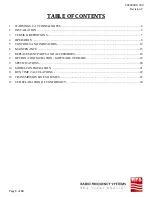
602400011500
Revision C
Page
5
of
24
2
INSTALLATION
2.1
System
Purging:
Proper purging of the site’s distribution
system prior to dehydrator installation is
important. Failure to do so may result in
moisture being present in the system when the
dehydrator is installed. This moisture will
remain in the system until the dehydrator’s
normal operation purges it from the system.
If the purging is left to normal operation of
the dehydrator, then the process may take days,
weeks, or longer depending on the dehydrator’s
installed options, system size, moisture levels,
and other variables. If configured, humidity
alarms may result until the humidity is purged
from the system.
Manually purging the pressure from the
system every 24 hours and letting the
dehydrator refill the system with dry air can
accelerate the moisture removal process.
2.2
Flow
Restrictions:
Care must be taken to ensure that no flow
restrictions exist in the site’s pressurized dry air
distribution system. Small restrictions can cause
pump times to be shorter than calculated, unit
duty cycle to increase, and system upper
operating pressures to be reduced.
Large restrictions can cause continuous
cycling of the dehydrator, which can cause issues
in the waveguide or cable system and will
significantly reduce the performance and service
life of the unit.
2.3
Installation
Location:
The dehydrator is designed for free-standing
operation on its vibration isolating rubber feet.
The dehydrator should be placed on a firm, level
surface. An accessory wall / rack mount shelf is
available for alternative mounting methods and
locations.
The APD series dehydrator requires a
minimum of 2" clearance on the sides and top for
proper heat dissipation.
2.4
Installation
Procedure:
2.4.1
Ensure that the site’s distribution system
has been properly installed, purged with
Nitrogen and sealed.
2.4.2
Unpack
the
dehydrator
in
the
environmentally
controlled
location
where it will be installed. Place the unit
on a flat, stable surface.
2.4.3
Make sure that nothing is connected to
the dehydrator’s output fitting.
2.4.4
Energize the dehydrator and let it run
with nothing connected to the dry air
output fitting for 3-5 minutes.
2.4.5
At this point the only indicators
illuminated
should
be
POWER,
COMPRESSOR and LOW PRESSURE.
2.4.6
De-energize the dehydrator and install it
in its final location.
2.4.7
Connect the dehydrator’s output to the
site distribution system using a properly
sized section of supplied 3/8” tubing.
2.4.8
Open all necessary distribution system
valves and energize the dehydrator.
2.4.9
The dehydrator will pressurize the
distribution system. Monitor the time it
takes to pressurize the system. If the unit
run time alarm option is configured, then
verify that the run time alarm setting is
above the unit’s measured run time.
2.4.10
Installation is now complete. Once normal
operation is confirmed, then an alarm
monitoring system can be connected.






































